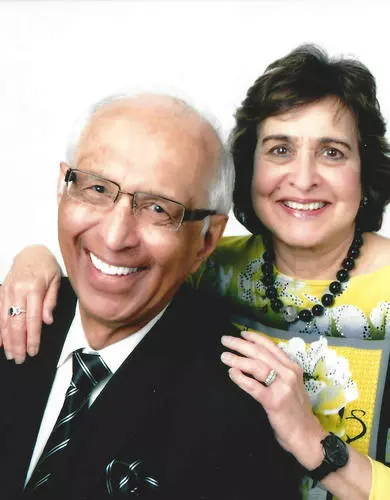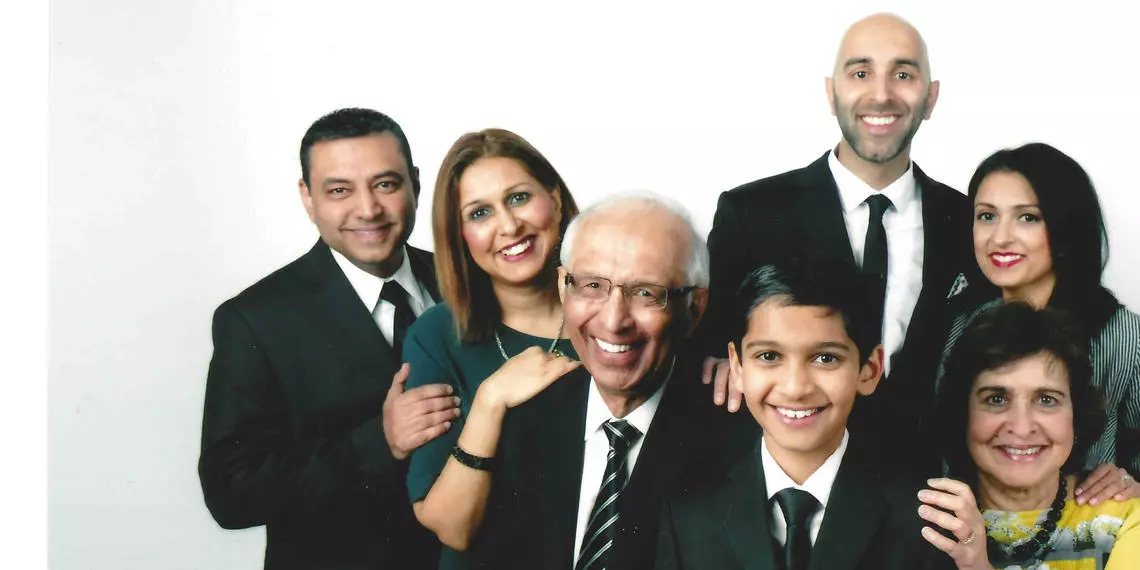
How does splitting an order of eggs Benedict and a tea bag allow someone enough capital to create not one, but hundreds of awards and scholarships?
ot that we’re counting, but if we were, Esmail Bharwani and his wife, Safana, stand out for the sheer volume of scholarships they’ve created and contribute to at the University of Calgary.
And not just here, but other post-secondary institutions from Bow Valley College and Mount Royal University to Athabasca University. All benefit from the 90-plus annual scholarships (perpetual) that are distributed through the Bharwanis' family foundation.
Some of their student scholarships target newcomers to Canada, while others aim to help single parents — some are $250, others are as high as $1,000.
“It’s quite simple, really: I am interested in maximizing the number of students who can benefit from our gifts,” explains Esmail, LLB’04, over a shared lunch at OEB Breakfast Co.
Splitting a lunch, down to a tea bag, precisely reflects his outlook on finances.
“Of course, we don’t have to split an eggs Benedict,” Esmail chuckles. “But it’s why I don’t have to eat at a posh restaurant or have a $70 steak . . . I can find a $20 meal and be just as happy. Why waste $50 when I could put that money into the Foundation or give somebody an award? I tell my kids that I don’t waste money on anything that really has no value in my life.”

The Bharwani family
But will a $250 scholarship make that much of a difference in someone’s education?
“My thinking is this,” explains the Tanzanian retiree, whose career saw him progress from stenographer to accountant to UCalgary-educated lawyer. “It's better to give small amounts to 10 people than give one large amount to one person. I like to think of the process like a Lotto 6/49 ticket. Sure, one person could win the $49-million jackpot but, frankly, I'd rather see 49 people get $1 million each. That way, you make 49 families happy.
“Over the years, lots of students have told me that even a small amount has helped them buy groceries that month because they had just spent all their money on student fees or tuition."
In the world of philanthropy, the Biblical parable of the loaves and fishes is one that’s frequently replayed, just as it is in many religions, including something similar in the Ismaili faith, which the Bharwanis ardently follow. Indeed, Dr. Sheila LeBlanc, DBA, associate vice-president of Continuing Education at UCalgary, confirms that, by 2027, the Bharwani family foundation will have contributed to 149 awards at Continuing Education, alone.
Like the miracle that fed 5,000, one of the tenets of being an Ismaili is sharing your material wealth in order to improve the quality of your community — something that greatly influenced Esmail while growing up with seven siblings in Tanzania.
“There was never a lot of money, but, somehow, we always had food or a cup of tea to share,” he says. “I remember once saying to my dad, ‘But, we are struggling ourselves.’ That’s when he explained the principle of barakat, which is, when you share what you have with someone, the god gives you barakat. In other words, barakat means bounty . . . good health, happiness. It’s a multiplying factor, a theory I’ve worked with all my life.”

Safana and Esmail Bharwani
And, if anyone knows the power of multiplying factors, it’s Esmail, who spent most of his career toiling over numbers. It started with a large family: eight children. The obligation of being the oldest son was to help with the family business while supporting his siblings through school. To do so, he quit school in Grade 9, helped run the business, and learned (and, soon after, taught) stenography, all the while aching for something more academically challenging. Years later, he found it in a professional accounting designation in Newcastle, England, and convinced his father that it was his turn.
Despite his frugal ways, Esmail had no capital after a year and was just about to return, defeated, to Tanzania when a white knight, in the guise of a professor, found him a job and a room at a Methodist hostel which carried him through to graduation. The years that followed saw Esmail, later with Safana, work between Africa and the U.K. before moving to Calgary in 1973, where, he says, “I learned what a parka was . . . it was freezing!”
Just 11 days after arriving in Calgary, Esmail secured a job as an accountant with S. J. Thomson Truck Equipment. A few years later, he began teaching a course in running a small business for UCalgary Continuing Education, which he did for the next 20 years. He earned a BA from Athabasca, an MBA from the University of Wales/Manchester Business School, and an MSc in entrepreneurialstudies from the University of Stirling in Scotland. Somewhere in those busy years, he began writing a weekly column in the Calgary Herald (which ran for 10 years), was a UCalgary senator for six years, and ran his own accounting practice, from which he retired in 1999. Impressive as those credentials are, Esmail discovered he was still hungry to learn, even as a retiree, and pounced on the opportunity to study what he’d always dreamed of taking — law.
“As a little boy, I used to go the courthouse and listen to all the big diamond-smuggling trials in Africa,” Esmail recalls. “So, I thought, why not? I have nothing else planned for the next three years.”
But nothing prepared the then-60-year-old for law school. “That first year was so tough,” he says. “Classes started at 8 a.m., and I would finish up at 2 in the morning in our basement, where I would have been studying since dinner.”
The oldest graduate of UCalgary Law’s Class of 2004, Esmail readily admits to crying as he walked across the stage in his cap and gown, thinking, incredulously, “I’m actually a lawyer now.”
After articling with Fraser Milner Casgrain LLP, Esmail joined the Miller Thomson LLP firm where he focused on income tax planning and compliance and worked until 2011. His law practice also allowed him to advise clients on setting up funds and charities, which is how he soon found himself running legal seminars from Toastmasters breakfasts and entrepreneurial student groups to UCalgary seminars and Canadian Bar Association lunches.
Esmail funnelled much of his income as a lawyer into the Esmail Safana Farzana Fayaz Bharwani Foundation, where he learned how satisfying philanthropy can be.
“Again, and I say this a lot . . . philanthropy comes from creating a surplus, however small that is,” says the grandfather of three. “I treat it like an accounting exercise. I ask myself, ‘What can I cut to create a surplus?’ But, remember — the goal is to help others, not to increase your business’ bottom line. You don’t have to be a millionaire to be a philanthropist. What you need is the desire, and then you need to make the effort, to create a surplus.
“Honestly, it’s simple math.”
https://alumni.ucalgary.ca/news/mega-do ... et-formula




